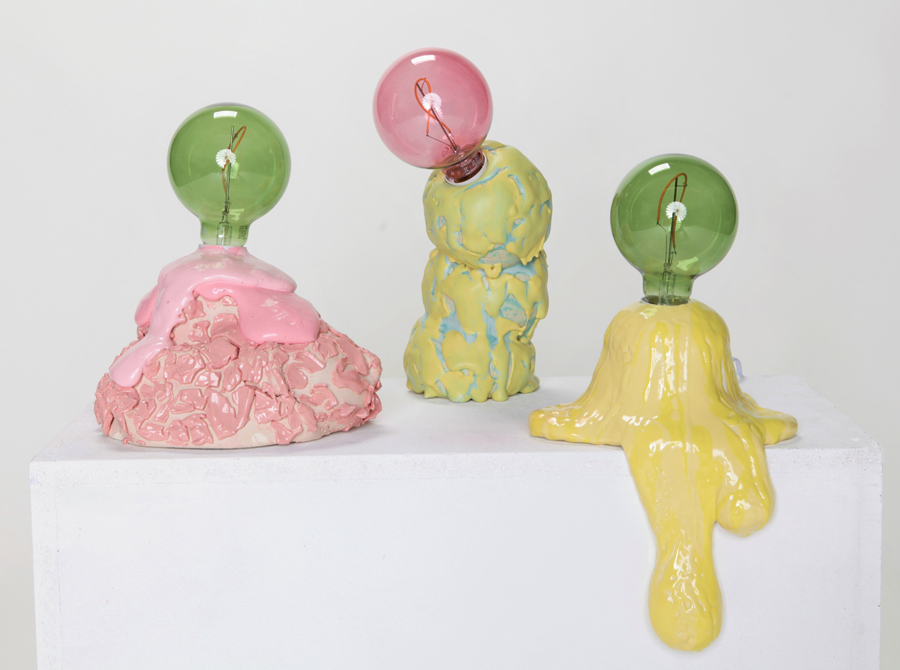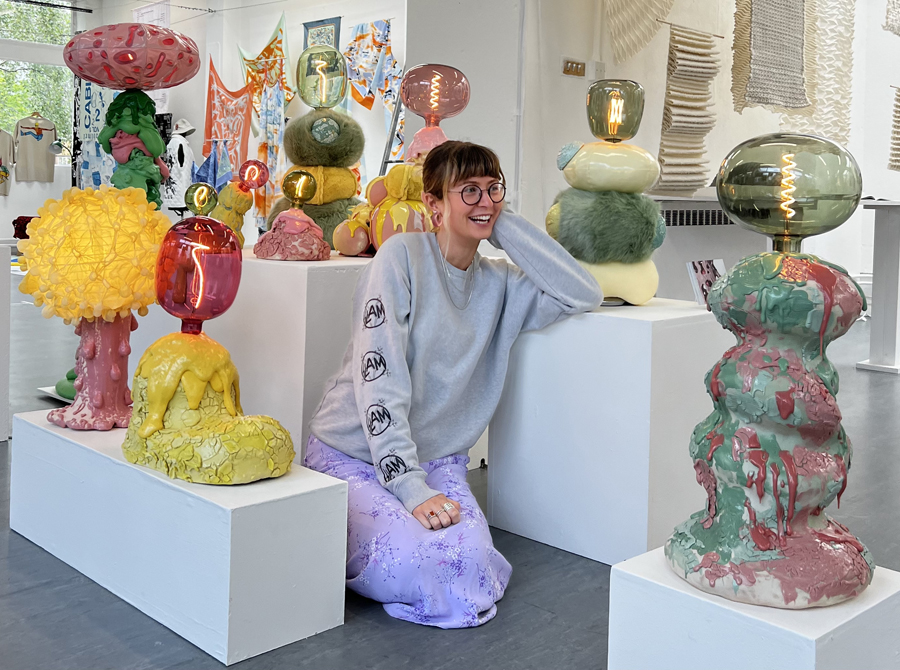2022 AWARD WINNER | Loughborough University
Posted on - 10th August 2022


ELLEN SMITH
Loughborough University | BA Hons Textiles: Innovation and Design
Tell us about yourself, your work, and your career path so far.
I am a mixed media object designer, amalgamating experimental ceramic and glaze practice with tactile sculptural forms in my debut lighting collection; Kneaded Lamps. Despite having studied Textile Design at university, I developed a love for clay work during the course of the final year of my degree and challenged myself to combine my textile and sewing knowledge with my new intrigue for ceramic and glaze experimentation. Studying ceramics through the lens of a Textile degree really allowed me a huge amount of freedom to combine different materials and tactile surfaces to create something with a playful juxtaposition of hard and soft, with the aim of igniting our most juvenile desires to feel, squeeze and poke.
Describe your first encounter with clay?
My initial encounter with clay was during the first semester of my final year at university - I created a selection of ceramic embellishments for a piece within a textile collection I was designing. I quickly realised that I enjoyed this process far more than any of the textile and sewing techniques I had been refining during my degree. More often than not, I found myself drawn to designing in a three-dimensional and sculptural way throughout my textile work, and upon discovering clay work, I felt like I had found the perfect medium for my unique design perspective.
Why did you choose ceramics?
I have always favoured 3D and tactile design; repeatedly choosing to design for interiors and space, whenever given the option during my studies. Once I started working with ceramics, I found my designs were more resolved and I could achieve forms and outcomes that I could never accomplish using textile techniques. It felt like the solution to so many design problems I encountered while I was limiting myself to the binary of fabric. Once I started experimenting with glaze properties, I found a new drive and motivation for my work that I’d never really felt before, kiln-opening days felt like Christmas morning because I’d wait in such anticipation, never knowing for certain what I’d get out of the firing but when a desired glaze effect was achieved, it was really exciting.
Where do you find inspiration? Places, people, objects, music…
A hedonistic and juvenile perspective comprises the conceptual foundation upon which the Kneaded Lamps design investigation was built. Exploring the simplest and earliest sources of joy, Kneaded Lamps are inspired by sweet treats, childhood toys and formative play. By reconnecting with and exploring my earliest and most infantile experiences of manipulating 3D form; kneading dough, bubbles in the bath, playdough, and wet sand, I gathered research that has simultaneously informed both the conceptual and visual¬ components of the project. Widely experienced and communally nostalgic tactile interactions have been manifested within the pieces to revive the childhood curiosity within myself while creating them and then inevitably for whoever comes to observe them. Acknowledging our instinctive desire to engage with things that evoke happiness is both indulgent yet essential, and in this serotonin packed experimental lighting project, I have married these two components together in harmony. As William Morris said; do not have anything in your home that you do not believe to be beautiful or know to be useful, a proverb I have held close throughout this project as I strive to combine form and function.
What are the tools of your trade that you can't do without?
When it came to the making of these lamps, I tried to use my hands as much as possible in order to remain in-tune with the conceptual nature of the project - hand-building everything felt natural to me as someone with a more limited experience in ceramic work. However, I must give honourable mention to the extruder and also the spray gun, as I applied an initial engobe to many of my pieces.
What is a typical day in the studio like?
As a lot of my practice was based around glaze experimentation, so many of my studio days would consist of mixing up lots of batches of different glazes, varying weights of ingredients to see what unusual glaze properties I could achieve. I became particularly interested in gloop and crawl glazes so I spent a lot of time altering flux quantities, kiln temperatures and the thickness of glaze pastes for chunky and unorthodox glaze surfaces.
What do the next 12 months have in store for you?
For now, I am working on setting up my own studio from which I can continue my practice and build my brand ‘Ellen’s Objects’ to create many more unique and bespoke ceramic lamps and other object designs that I have in the works.
What advice do you have for those currently studying ceramics in further education?
Don’t be afraid to fail! I feel like I avoided trying new techniques for so long, in fear of encountering a disaster, but everything I’ve achieved in ceramics this past year has only been possible from a series of failed samples that came first. In every failure there is a lesson and its safe to say I learnt A LOT but without those lessons, none of it would’ve been possible!

